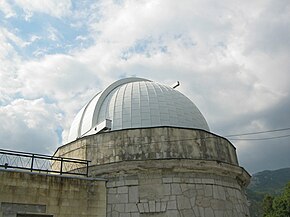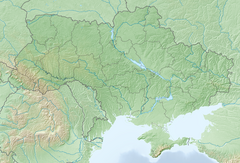Simeiz Observatory
 | |
| Named after | Simeiz |
|---|---|
| Observatory code | 094 |
| Location | Yalta Municipality, Autonomous Republic of Crimea, Ukraine |
| Coordinates | 44°25′05″N 33°59′51″E / 44.418038888889°N 33.9974°E |
| Altitude | 360 m (1,180 ft) |
| Established | 1908 |
| Telescopes | |
| | |
Simeiz Observatory (also spelled Simeis or Simeïs) was an astronomy research observatory until the mid-1950s. It is located on Mount Koshka, Crimea, by the town of Simeiz.
Part of the Crimean Astrophysical Observatory, it is currently used for laser based studies of the orbits of satellites.
The Minor Planet Center (MPC) credits Simeiz Observatory as the location where a total of 150 minor planets were discovered by astronomers Grigory Neujmin, Sergey Belyavsky, Vladimir Albitsky, Grigory Shajn, Nikolaj Ivanov, Pelageya Shajn, Praskov'ja Parchomenko, Alexander Deutsch and Evgenij Skvorcov.
As of 2017, the discovery of the minor planet (369010) 2007 OK2 is directly credited to Simeiz Observatory by the MPC.[1]
History
[edit]
The Simeiz Observatory was founded by Russian amateur astronomer Nikolai Maltsov, who later became a honored member of the Russian Academy of Sciences and after whom asteroid 749 Malzovia was named. In 1900, he built a tower for refractor at his land plot near Simeiz. In 1906 – a tower with dome for Zeiss double astrograph. Both towers are preserved and being used nowadays. In 1908, Maltsov handed his observatory to Pulkovo Observatory as a present. In 1912, the first astrophysical department of Pulkovo Observatory was officially opened at the south of Russia. Simeiz observatory is situated at the level of 360 m above sea level at southern mountainside of the Crimean mountains, at Koshka mountain. A main building was restored after the Second World War on the basis of old building in modernized style with balconies decorated by columns.
Research of interstellar space and star formation zones, discovery of star rotation, creation of stellar catalogues of radial velocities, study of chemical composition of stars and the Sun brought the world publicity to Simeiz Observatory. The results of research of stars and the Sun represents an independent value.
The Department provides observing facilities for astronomers of international community and for its own staff. The following projects currently run:
- Very Long Baseline Interferometry (VLBI)
- Multi-wavelength monitoring of Active Galactic Nuclei (AGN)
- Solar and stellar activity investigations
- Molecular lines observations at mm wavelengths
Discoveries
[edit]Minor planets, whose discovery is directly credited to the observatory (rather than a particular astronomer).[1]
| (369010) 2007 OK2 | 18 July 2007 | list |
In the 1950s the observatory issued several lists[2] of galactic emmission nebulas, published by G. A. Shajn and V. F. Gaze (also transliterated Hase) in the Ukrainian "Bulletin of the Crimean Astrophysical Observatory" (Izvestiya Krymskoi Astrofizicheskoi Observatorii) and known collectively as the Simeis catalogue.[3] The catalogue includes Simeis 57 (the Propeller Nebula in Cygnus)[4] and Simeis 147 (the Spaghetti Nebula in Auriga).
See also
[edit]References
[edit]- ^ a b c "Minor Planet Discoverers (by number)". Minor Planet Center. 4 September 2016. Retrieved 27 December 2016.
- ^ "Dictionary of Nomenclature of Celestial Objects". CDS Portal. University of Strasbourg. 2024. Retrieved 28 September 2024.
- ^ "sim". CDS Portal. University of Strasbourg. 2024. Retrieved 28 September 2024.
- ^ Gábor Tóth (2014). "The Propeller Nebula - Simeis 57". Gábor Tóth Astrophotography. Retrieved 28 September 2024.
External links
[edit]- People and Stars History of Simeiz Observatory, Nikolay Semyon "Mirror of the week" No. 42, October 1998 (in Russian)
- Crimean Astrophysical Observatory, a detailed history of Simeiz and Crimean Astrophysical Observatory by Petr Pavlovich Dobronravin (in Russian).
- Brief history Brief history of Simeiz and Crimean Astrophysical Observatory.
- History of minor planet observations at the Crimean astrophysical observatory, L. I. & N. S. Chernykh (2002)

